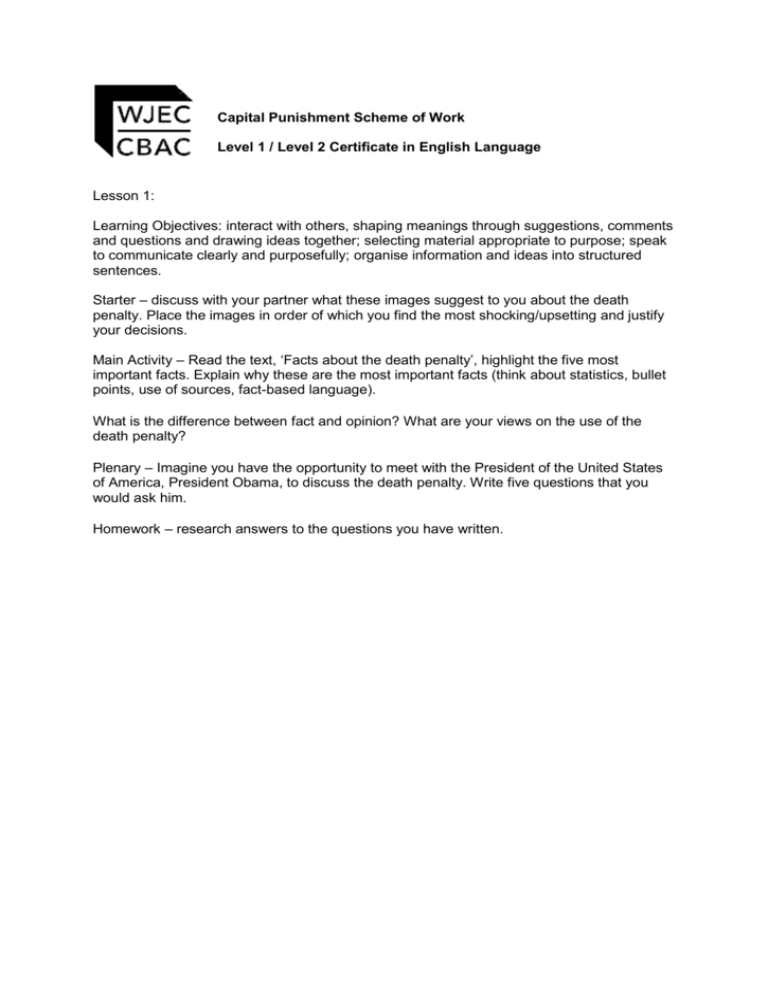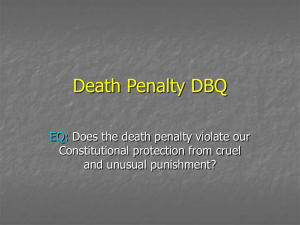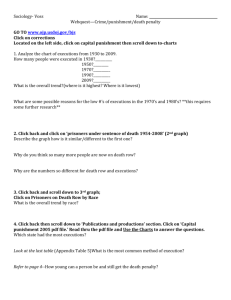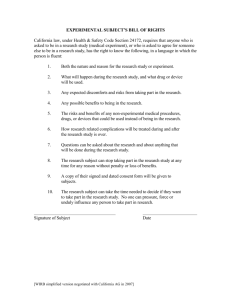Capital Punishment Scheme of Work Level 1 / Level 2 Certificate in
advertisement

Capital Punishment Scheme of Work Level 1 / Level 2 Certificate in English Language Lesson 1: Learning Objectives: interact with others, shaping meanings through suggestions, comments and questions and drawing ideas together; selecting material appropriate to purpose; speak to communicate clearly and purposefully; organise information and ideas into structured sentences. Starter – discuss with your partner what these images suggest to you about the death penalty. Place the images in order of which you find the most shocking/upsetting and justify your decisions. Main Activity – Read the text, ‘Facts about the death penalty’, highlight the five most important facts. Explain why these are the most important facts (think about statistics, bullet points, use of sources, fact-based language). What is the difference between fact and opinion? What are your views on the use of the death penalty? Plenary – Imagine you have the opportunity to meet with the President of the United States of America, President Obama, to discuss the death penalty. Write five questions that you would ask him. Homework – research answers to the questions you have written. Lesson 2: Learning Objectives: read and understand texts; interpretations of writers’ perspectives; write to communicate clearly and effectively, using and adapting forms and selecting vocabulary appropriate to task and purpose in ways which engage the reader; organise information and ideas into structured and sequenced sentences and paragraphs, using a variety of linguistic and structural features to support cohesion and overall coherence; use a range of sentence structures for clarity, purpose and effect, with accurate punctuation and spelling; structure and sustain talk; listen and respond to speakers’ ideas; interact with others. Starter – listen to ‘Folsom Prison Blues’ and read the lyrics. Discuss with your partner whether this man should receive the death penalty. List the reasons for and against this man receiving the death penalty. Main Activity – Read the blogs where posters have expressed their opinions about the death penalty. List in two columns the reasons they give for and against the death penalty. Write three detailed paragraphs, agreeing or disagreeing, on the following statement: “The death penalty can never be justified”. Plenary – Choose a statement from your argument, read it out and then using one of the following connectives – However, Although, Despite this, Conversely – provide the counterargument. For example, “The death penalty should only be used for violent crimes. However, proving the accused guilty is always difficult.” Lesson 3: Learning Objectives: develop interpretations of writers’ perspectives; explain and evaluate how writers use linguistic features to achieve effects and influence the reader; listen and respond to speakers’ ideas; interact with others. Starter – read these two definitions of capital punishment from two different sources. “Capital punishment, the death penalty, or execution is the sentence of death upon a person by judicial process as a punishment for an offence. Crimes that can result in a death penalty are known as capital crimes or capital offences.” (Wikipedia) “The death penalty is the ultimate denial of human rights. It is the premeditated and coldblooded killing of a human being by the state. This cruel, inhuman and degrading punishment is done in the name of justice. It violates the right to life as proclaimed in the Universal Declaration of Human Rights.” (Amnesty International) Which definition, in your opinion, is better and why? Now write your own definition of what capital punishment means to you. It is important to use your own words. Main Activity – look again at the Amnesty International definition. Identify the emotive language used in this definition, and how that language tries to affect your opinion of the death penalty? Using a thesaurus, choose alternative for the highlighted words. OR … Rewrite the following text from Amnesty International so that it is pro-death penalty. Plenary – Is there a difference between referring to capital punishment as opposed to the death penalty? Discuss with your partner which is the most appropriate term of reference and why. Lesson 4: Learning Objectives: read and understand texts, selecting material appropriate to purpose; develop and sustain interpretations of writers’ ideas and perspectives; explain and evaluate how writers use linguistic, grammatical, structural and presentational features to achieve effects and engage and influence the reader; organise information and ideas into structured and sequenced sentences. Starter – list the techniques you could use to persuade a reader/audience to agree with your viewpoint. Main Activity – read Danny Glover’s speech and with your partner. Identify the techniques he employs to argue against capital punishment. Write a practice answer to this question: How does Danny Glover try to persuade the audience to agree with his views on the death penalty? Plenary – identify in your partner’s answer where he/she has used ‘Point, Evidence, Explanation’ effectively. Lesson 5: Learning Objectives: write to communicate clearly, effectively and imaginatively, using and adapting forms and selecting vocabulary appropriate to task and purpose in ways which engage the reader; organise information and ideas into structured and sequenced sentences, paragraphs and whole texts, using a variety of linguistic and structural features to support cohesion and overall coherence; use a range of sentence structures for clarity, purpose and effect, with accurate punctuation and spelling; interact with others, shaping meanings through suggestions, comments and questions and drawing ideas together. Starter – discuss these questions about the purpose of the death penalty with your partner. Which, if any, do you agree with? Is the purpose of the death penalty to remove from society someone who would cause more harm? Is the purpose of the death penalty to remove from society someone who is incapable of rehabilitation? Is the purpose of the death penalty to deter others from committing murder? Is the purpose of the death penalty to punish the criminal? Is the purpose of the death penalty to take retribution on behalf of the victim? Is the purpose of the death penalty to cut costs of keeping criminals in prison? Main Activity – Read The Telegraph article about the restoration of capital punishment in the United Kingdom. Write a letter to your local MP to persuade him/her to agree with your views on whether capital punishment should be re-introduced in the United Kingdom. Plenary – Write one sentence that most powerfully presents your views on capital punishment. Share this with the rest of the class. Lesson 6: Learning Objectives: read and understand texts, selecting material appropriate to purpose, collating from different sources and making comparisons and cross-references when appropriate; develop and sustain interpretations of writers’ ideas and perspectives; explain and evaluate how writers use linguistic, grammatical, structural and presentational features to achieve effects and engage and influence the reader; interact with others, shaping meanings through suggestions, comments and questions and drawing ideas together. Starter – Read the case of Stanley "Tookie" Williams, which illustrates the moral complexities of the death penalty. Discuss with your partner whether Stanley Williams should have received a lethal injection as his punishment? Mr. Williams, an author and Nobel Peace and Literature Prizes nominee who was put to death on December 13, 2005 by lethal injection by the state of California, brought capital punishment back into prominent public debate. Mr. Williams was convicted of four murders committed in 1979, and sentenced to death. Williams professed innocence of these crimes. He was also co-founder of the Crips, a deadly and powerful Los Angeles-based street gang responsible for hundreds of murders. About five years after incarceration, Mr. Williams underwent a religious conversion and, as a result, authored many books and programs to promote peace and to fight gangs and gang violence. He was nominated five times for the Nobel Peace Prize and four times for the Nobel Literature Prize. Mr. Williams' life was one of self-admitted crime and violence, followed by genuine redemption and a life of uniquely and unusually good works. The circumstantial evidence against Williams left little doubt that he committed the four murders, despite last-minute claims by supporters. There also existed no doubt that Mr. Williams posed no further threat to society, and would contribute considerable good. Main Activity – Read the article reporting on the shootings in Norway in 2011 and then the Reuters article on the same event. Answer the following questions: 1. What do we learn about the man responsible for these shooting from each text? Newspaper Article Reuters Article 2. What do we learn about Norway’s legal system? …………………………………………………………………………………………………. …………………………………………………………………………………………………. …………………………………………………………………………………………………. …………………………………………………………………………………………………. …………………………………………………………………………………………………. …………………………………………………………………………………………………. …………………………………………………………………………………………………. …………………………………………………………………………………………………. …………………………………………………………………………………………………. …………………………………………………………………………………………………. 3. How do the eye witness accounts affect the reader? Think about: What is said How it is said. Plenary – What are your opinions about the Norway massacre? Is this different to Stanley Williams’ case? Homework – write a discursive essay about reintroducing capital punishment in the UK.








